#oriental institute
Text
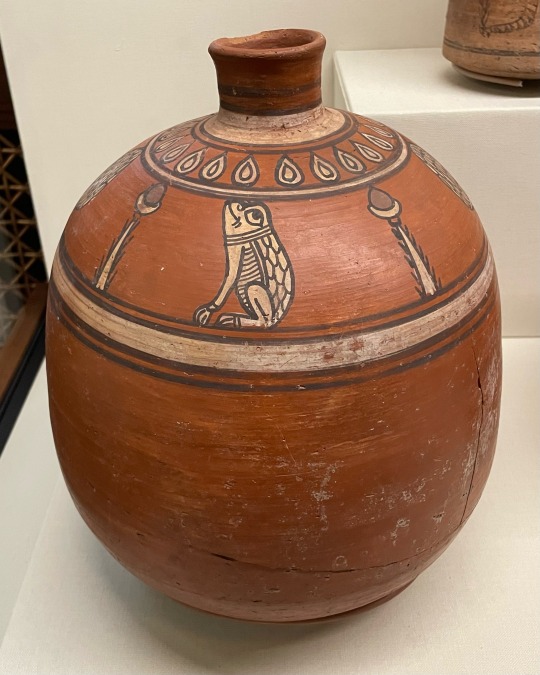
For #FroggyFriday:
polychrome clay jar with seated frogs
Egypt, Ballana, Cemetery B, Tomb 208
Meroitic period, Phase IVA (250-270 CE); excavated in 1963-64
Spotted on display at Oriental Institute - University of Chicago.
#frog#frogs#ceramics#polychrome#ancient Egypt#Meroitic#ancient art#clay#jar#Oriental Institute#animals in art
60 notes
·
View notes
Text
Photo for Thursday
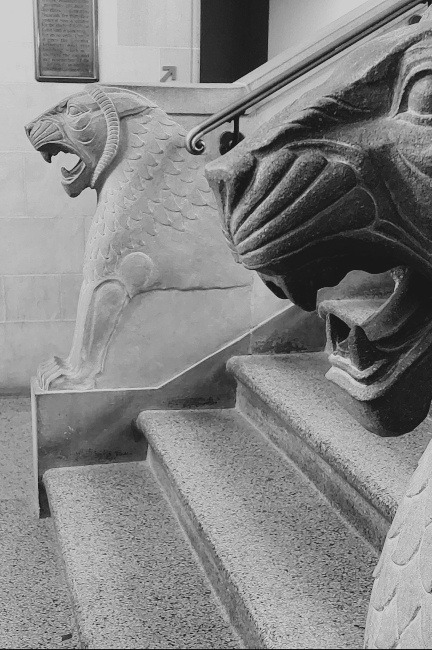
Guardians, Oriental Institute, University of Chicago
10 notes
·
View notes
Photo


Repoussé door pole bands, depicting the king holding the horns of two bulls, a bird, a fig tree, and the tip of a plow
Shamash Temple, Dur-Sharrukin (Khorsabad, Iraq)
Neo-Assyrian period, reign of Sargon II (721-705 BCE)
Oriental Institute Museum, University of Chicago
#neo-assyrian#Sargon ii#dur sharrukin#khorsabad#art history#archaeology#oriental institute#mesopotamia
40 notes
·
View notes
Photo
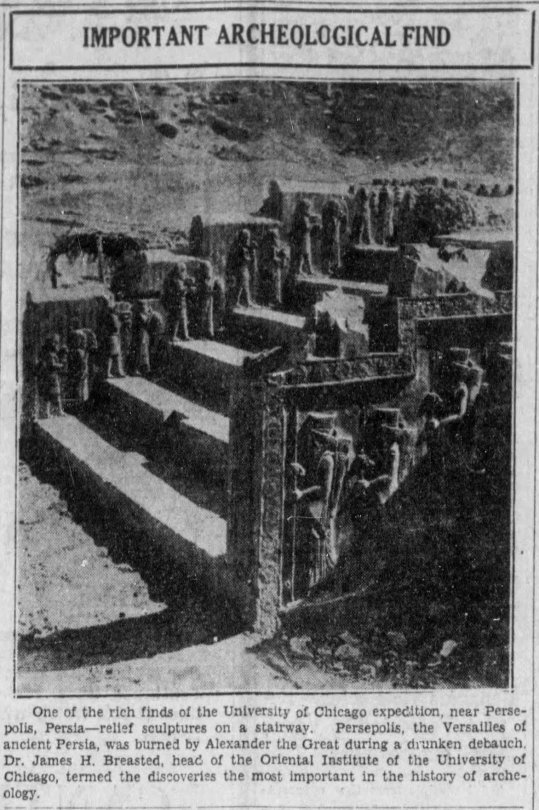
“IMPORTANT ARCHEOLOGICAL FIND,” Kingston Whig-Standard. January 26, 1933. Page 1.
----
One of the rich finds of the University of Chicago expedition near Persepolis, Persia — relief sculpture on a stairway. Persepolis, the Versailles of ancient Persia, was burned by Alexander the Great during a drunken debauch. Dr. James H Breasted, head of the Oriental Institute of the University of Chicago, termed the discoveries the most important In the history of archaeology.
#achaemenid empire#achaemenid persia#ancient persia#persepolis#university of chicago#archaeological dig#oriental institute#archaeological excavation
3 notes
·
View notes
Text
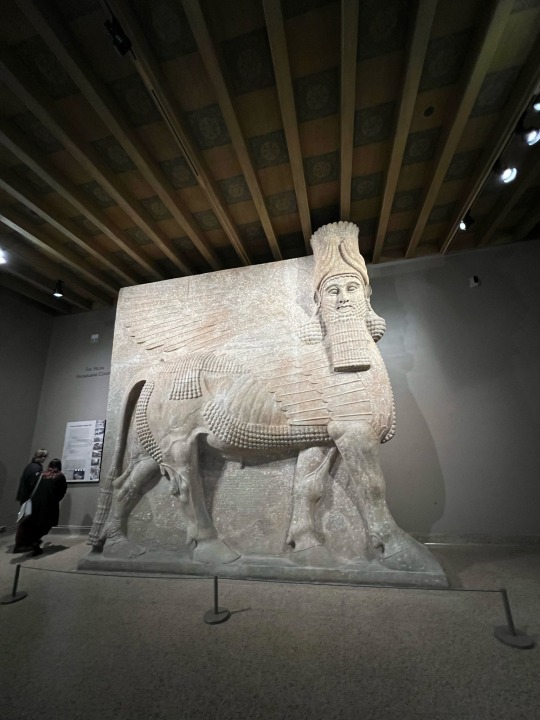

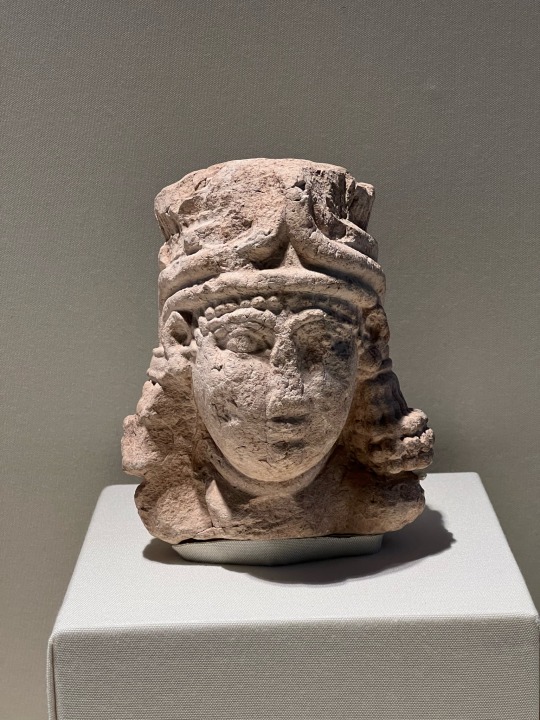




Oriental Institute Museum, the Mesopotamian exhibit
#mesopotamia#exhibition#exhibit#babylon#assyrian#culture#history#museum#stolen art#chicago#oriental#institute#oriental institute#follow me#historical#iran#iraq#stones#modern day iraq#animals#grand#statues#art#art museum#carvings#sculptures
5 notes
·
View notes
Text

In commemoration of the 100th anniversary of the Oriental Institute of the Czech Academy of Sciences, the Oriental Institute and the National Gallery Prague brought three lantern-craft specialists from Kyoto, Japan, to Prague. The Japanese master lantern KOJIMA (小嶋) was created in Prague, at a workshop held at the National Gallery (https://toyosawa4.wixsite.com/lantern).
#KOJIMA#lantern#Japanese#master craftsman#Oriental Institute#anniversary#Czech Academy of Sciences#National Gallery#Kyoto#Japan#Mamoru KOJIMA#小嶋 護#Ryō KOJIMA#小嶋 諒#Shin'ya TAKEDA#武田 真哉#Stanislava Franců#Prague#Praha#Prag#Прага#Prága#Czech Republic#Czechia#Tschechien#République tchèque#Tchéquie#Чехия#Чешская Республика#Tschechische Republik
2 notes
·
View notes
Photo

Today a middle-aged woman brought a large book of wall reliefs from the Great Hypostyle Hall at Karnak to the front counter and began paging through it slowly. The book, by Harold Hayden Nelson, is Volume 106 of the University of Chicago Oriental Institute Publications. She shook her head. "All the old paintings on the tombs..."
Her voice faded away for a moment, and then she continued:
"They do the sand dance, don't you know?"
I allowed that I did not know as much as I wished about Egyptian art. She nodded, as if she understood that we could all stand to learn more. "If you move too quick," she said, "They're falling down like dominoes."
Yes, I agreed, it was reasonable to believe that if one attempted to dance too quickly, one might indeed stumble and fall.
"All the bazaar men by the Nile, they've got their money on a bet," she added. This confused me slightly. Did she say "bazaar men," or "bizarre men?" And I did not understand the relevance of gambling at the bazaar to falling while dancing. Before I could ask her to clarify, she blurted out: "Gold crocodiles. Way oh, way oh." Again, however, I might have misunderstood. Was she saying "Way oh," or "Weigh, oh?" Or perhaps "Whey, oh?"
"Gold crocodiles?" I asked.
Her tone took on that of a patient teacher, and she began to explain: "Foreign types with the hookah pipes say 'way oh, way oh. A-O, way oh.'" And then, as if she had now clarified everything, she said simply: "Walk like an Egyptian."
I was now entirely lost. It did not help that she immediately unleashed an additional torrent of what, to me at least, seem like nonsense: It was something about blonde waitresses taking trays while spinning and crossing floors and dropping drinks. Then she said one sentence that was downright hurtful, and I felt that she was taunting me:
"All the schoolkids, so sick of books, they like the punk and the metal bands."
"Sick of books, are they?" I interjected. "Perhaps you're sick of books as well. Perhaps I should just take this back." I grabbed the book and slammed it shut. "For your information, an affinity for books and an affection for punk and metal bands are by no means mutually exclusive. I myself am fond of... of..." I admit that it took me a moment to remember the name of any such bands, but they eventually came to me. "Wyld Stallyns! And Cradle of Filth! I've written about them on my blog! All you have to do is search."
She shrugged and headed for the door. As she walked, she continued talking, saying something about buzzers and marketplaces and back-bending and arm-shifting. I followed her toward the door, and the last thing I heard her say before the door shut behind her was, "Life is hard, you know."
Yes, I thought, life IS hard. Especially if you own a bookstore.
#egypt#egyptian art#ancient egypt#bookstores#azairaphale#walk like an egyptian#wyld stallyns#cradle of filth#harold hayden nelson#university of chicago#oriental institute
17 notes
·
View notes
Photo
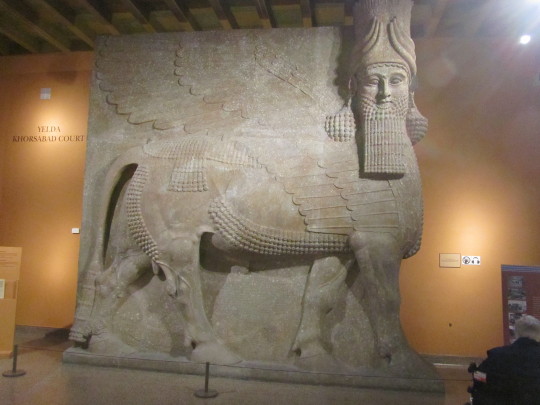

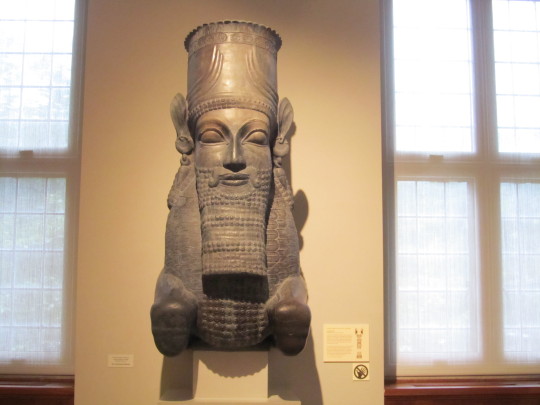
More photos from the Oriental Institute, Chicago, this time 2016
1 note
·
View note
Text
The most typical office thing I've seen in the Magnus archives is when Jon returns from his coma and all of his pens are gone but no one bothered to clean out enough to get rid of the suspicious jar of ashes that was left in his drawer
A clear indication that it wasn't a courtesy cleanup. It was an office supply raid
2K notes
·
View notes
Text
Mike Crew aroace cause I said so
#tma#tma spoilers#mike crew#the vast#the magnus institute#the magnus archives#magnus archives#aroace#asexual#aromantic#lgbtq+#he’s oriented aroace#gay#he likes guys ok there’s other types of attraction
51 notes
·
View notes
Text
Ancient Treasures Beeing Uncovered Waiting Excibition
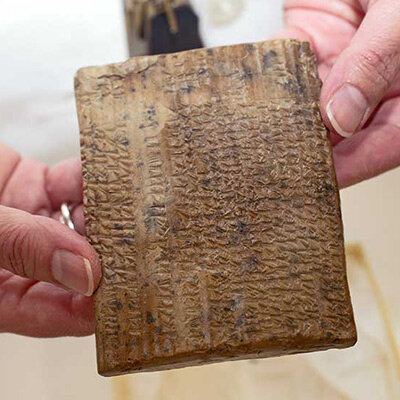
TEHRAN - More than two months have passed since the recovery of 3506 Achaemenid tablets, and the time for their unveiling has not yet been determined. However, the director of the National Museum of Iran announced their imminent display in this museum soon.
It was late in September that 3506 Achaemenid tablets were returned to Iran after nearly 90 years, accompanying the President's plane.
The treasured tablets were returned home by the plane carrying President Ebrahim Raisi, who addressed the 78th session of the United Nations General Assembly during his visit to New York.
These clay tablets were part of a larger shipment discovered at Persepolis in 1311, which was entrusted to the Oriental Institute of Chicago for deciphering and study.
Out of over 30,000 pieces held by the Chicago Institute for study and deciphering, five shipments have been returned to Iran in the Iranian years 1327 (1948-49), 1330 (1951-52), 1383 (2004-05), 1398 (2019-2020), and 1402 (2023-24), ISNA reported.
Yet, portions of these tablets still remain at the institute. Ezzatollah Zarghami, the Minister of Cultural Heritage, Tourism, and Handicrafts, had previously mentioned the process of returning the remaining tablets, stating that the groundwork for their return has been laid out. “According to an agreement made by the Americans, our experts will go to that country to verify the remaining tablets, after which they will gradually be returned to Iran.”
However, the fifth shipment, arriving in Iran on September 21 this year, consisted of 836 small tablets in Aramaic script and 2670 large tablets in Elamite script. They were shipped in nine boxes each weighing 75 kg. They were ultimately delivered to the National Museum of Iran.
It was planned that after quarantine, inspection, and study, some of these tablets would be put on display. Jebrael Nokandeh, the director of the National Museum of Iran, responding to ISNA regarding the timing of their display, stated: “It will be showcased soon.”.

He had previously mentioned the possibility of showcasing the Achaemenid tablets during Research Week (Dec. 16 to 20), but upon ISNA's follow-up, he responded: "The time for display (of the fifth shipment of recovered Achaemenid tablets) is approaching."
Studies conducted thus far on the Achaemenid clay tablets indicate that their content encompasses the administration and upper echelons of society during that historical period.
Archaeologists affiliated with the University of Chicago discovered the tablets in the 1930s while excavating in Persepolis, the ceremonial capital of the Persian Empire. However, the institute has resumed work in collaboration with colleagues in Iran, and the return of the tablets is part of a broadening of contacts between scholars in the two countries, said Gil Stein, director of the Oriental Institute at the University of Chicago.
They are very important sources of information revealing economic, social, and religious data about the Achaemenid Empire (550-330 BC) and the larger Near Eastern region in the fifth century BC.
Persepolis, locally known as Takht-e Jamshid, was the ceremonial capital of the Achaemenid Empire. It ranks among the archaeological sites, that have no equivalent, considering its unique architecture, urban planning, construction technology, and art.
Narratives say that Persepolis was burnt by Alexander the Great in 330 BC apparently as revenge against the Persians because it seems the Persian King Xerxes had burnt the Greek City of Athens around 150 years earlier. It was the largest and most durable empire of its time, stretching from Ethiopia, through Egypt, to Greece, Anatolia (modern Turkey), Central Asia, and India at its height.
Source:https://www.tehrantimes.com/news/491889/Achaemenid-tablets-recovered-from-U-S-when-will-they-be-unveiled
#Iran#clay tablets#Ancient Iran#Achaemenid#Iran Tehran#New York#Oriental Institute of Chicago#Iranian Minister of Cultural Heritage#Tourism and Handicrafts#Jebrael Noccandeh#iran culture#ایران#arhcaeology#وزیر میراث فرهنگی، گردشگری و صنایع دستی#ایران باستان#باستان شناسی#موسسه شرقی شیکاگو#هخامنشی
8 notes
·
View notes
Text
Sumerian Beer

(Photography by Terren Wein)
“Five things I learned about Sumerian beer
Not just from a lecture, but a tasting.
By Author
Carrie Golus, AB’91, AM’93
|Web exclusives
— 04.09.2014
The esteemed scholars at the Oriental Institute—who have their priorities in order, as far as I’m concerned—have been working on Sumerian beer for half a century.
In 1964, Miguel Civil, a Sumerologist at the OI, published the first definitive translation of “A Hymn to Ninkasi.” Ninkasi, whose name literally means “lady who fills the mouth,” was the goddess of brewing.
Earlier translations of the hymn, relying on imperfect knowledge of Sumerian, had produced much different results, Civil observed: “A line that now even a first-year Sumerian student will translate ‘you are the one who spreads the roasted malt on a large mat’ was translated ‘thou real producer of the lightning, exalted functionary, mighty one!’”
The hymn describes the brewing process, in oblique, literary, grateful terms. For example:
Ninkasi, you are the one who soaks the malt in a jar,
The waves rise, the waves fall.
You are the one who spreads the cooked mash on
large reed mats,
Coolness overcomes…
You are the one who holds with both hands
the great sweetwort,
Brewing [it] with honey [and] wine…
The fermenting vat, which makes a pleasant sound,
You place appropriately on [top of]
a large collector vat…
While I circle around the abundance of beer,
While I feel wonderful, I feel wonderful,
Drinking beer, in a blissful mood,
Drinking liquor, feeling exhilarated,
With joy in the heart [and] a happy liver—
While my heart full of joy,
[And] [my] happy liver I cover with a
garment fit for a queen!…
The instructions for making beer, murky as they were, now existed in English. But another 25 years passed before anyone attempted to decipher the secret code.
In 1989 the Anchor Brewing Company of San Francisco, working with Civil and a bioanthropologist at the University of Pennsylvania, first tried to brew and bottle a Sumerian-style beer. Its creators pronounced it “drinkable.”
Another 20 years passed before a second attempt was made. This time, Pat Conway, AM’78, of Great Lakes Brewing in Cleveland, was determined not only to use the hymn as a recipe, but to brew the beer in clay vessels like those used 4,000 years ago.
With the help of graduate student Tate Paulette, AM’04, and other OI experts, Great Lakes created three Sumerian beers: Enkibru, a “baseline” beer, as Conway described it; the same beer with date syrup added at the end “to kick off the sweetness”; and Gilgamash, the same beer brewed on 21st-century equipment. The beers are named after Enkidu and Gilgamesh, the main characters in the Epic of Gilgamesh, Paulette explained to me later.
Last month, at a sold-out OI event called “A Hymn to Ninkasi,” I got to try them.
But first we all had to sit through an hour-long lecture by the Sumerologists at the OI and the brewers at Great Lakes. I’d be lying if I didn’t admit I was a bit squirmy by the end.
Nonetheless, here are five things I learned.
1. “Beer production predates the first cities, perhaps by thousands of years,” Sumerologist Chris Woods explained. “Beer production may even be as old as agriculture itself.” Beer in Mesopotamia was consumed by both men and women and all social classes.
2. There are “thousands upon thousands” of references to beer in the clay tablets of Mesopotamia, and yet not a single recipe, Woods continued. “The Hymn to Ninkasi” is the closest thing that has been discovered as of yet.
3. People drank beer out of a communal jar using long reed straws. The beer was probably still actively fermenting, “so you’d have a layer of husks and other stuff on top,” said Paulette. “The straws get down through that top layer, acting as a filter.” Beer drunk through a straw would also get into your system more quickly, he pointed out.
4. The two main ingredients of Sumerian beer were malted barley (barley that has been allowed to germinate) and bappir, usually translated as “beer bread.” But there are two big questions about bappir, Paulette said: “What was it, and how does it fit into the process?”
The OI-Great Lakes group decided to test the possibility that bappir introduced the yeast for fermentation; but if that were the case, the bread couldn’t be baked, or the yeast would die. So they worked with an artisanal baker in Cleveland who baked the bappir at an extremely low temperature—around 100 degrees, about how hot it gets in Iraq in the summer—for up to a week. “It was almost like drying out bread, rather than baking it,” said Paulette.
5. Sumerian beer is not my thing. Enkibru was cloudy and lemony; I heard other, more open-minded tasters describe it as “refreshing” and “kind of like shandy.” Enkibru with date syrup looked and tasted like dish soap; I didn’t hear any nice comments about this one. Gilgamash, brewed on modern equipment, was clear and light, a bit like the wheat beers that I’m partial to. I drank a pint of it and enjoyed it at the time, but woke up the next morning with a college-style hangover. My liver was not filled with joy.”
Source: https://mag.uchicago.edu/arts-humanities/five-things-i-learned-about-sumerian-beer
43 notes
·
View notes
Text
i am finally alive again after 2.5 days of being so sick i wasn't sure what timezone i was in. apparently i missed two mandatory meetings this week because i couldn't access my institutional email. i only signed up for payment and health insurance yesterday because HR just established that i am a person on like, tuesday. my start date was the first of the month.
#welcome to academia#i think maybe i was really spoiled by going to a state institution#where state laws require they onboard you two months in advance and remotely#i'm sure i'm pissing everyone off but also...i was barely standing upright on monday when i went to the fellows orientation#like i literally could not have gotten here sooner without sacrificing mine and my loved ones' wellbeing#so...................work with me here
3 notes
·
View notes
Photo

Cylinder seal impressions with animal combat scenes
Inana Temple, Nippur (Iraq)
Early Dynastic I period, ca. 2900-2600 BCE
Oriental Institute Museum, University of Chicago, A32233, A32247, and A33769
#mesopotamia#cylinder seal#seal impressions#nippur#early dynastic#art history#archaeology#oriental institute
4 notes
·
View notes
Text
erik alfred leslie satie you were the real one
#i mean that on all accounts. however. currently i am referring to the fact he dropped out of paris conservatoire twice#we both were too silly for the art music educational institutions 😔😔#being into avant-garde ideas and some of the styles sucks. how tf i dont fit in BOTH art and pop music standards and expectations#composition class is a f-g nightmare when you are schizoid (not into any poetry and expressing 'feelings' no matter mine or someone else's)#my professor doesnt allow pieces without an Idea; a Picture that is Painted by Notes. more they dont even exist to her.#and then theres me. flat affected fucker who rarely has Ideas (and even if i do neither i want to nor can explain them) but often Neat#Sound Combinations. oh and also most of the conventional themes/ideas disgust me (see: 95% of poetry and songs being about l*ve)#sigh why cant i just magically be left alone to finally live my truth#the orientation to the listener and their basic ass perception while writing music and yk. expressing _yourself_ by it is so sickening
1 note
·
View note
Text
Top Computer Courses to Pursue after 12th to get placed
Looking to pursue computer courses after 12th? Unlock a world of opportunities with the best computer courses in Delhi. From web development to data science and digital marketing, these courses empower you with the skills needed to thrive in the digital age. Choose the best computer course in Delhi and embark on a rewarding career journey.

#Best computer courses after 12th#Best computer course after 12th#Computer courses in Delhi#Computer course in Delhi#Basic computer course in Delhi#Computer institute in Delhi#Best computer course in Delhi with placement#computer courses#computer science#students#courses after 12th#job oriented courses#career guidance
2 notes
·
View notes